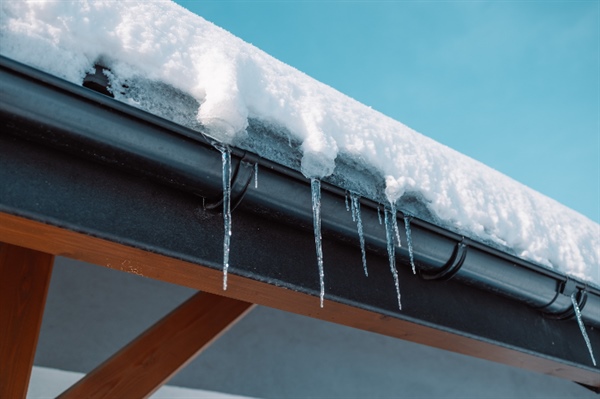Higgins Cold Climate Roofing Solutions: Our Expert Picks for Roofing Materials

Durability and efficiency are top priorities when it comes to roofing solutions in cold climates. Homeowners in regions with harsh winters, like Minnesota, face unique challenges such as heavy snowfall, ice dams, and extreme temperature fluctuations.
Selecting the right roofing materials protects your home, improves energy efficiency, and extends the life of your roof.
At Higgins Construction, we understand these challenges and aim to provide reliable roofing solutions tailored to cold climates. We want you to make the right choice for your property, so let's take a look at our expert picks.
How Does Snow Affect Roofing Materials?
Snow presents unique challenges for roofing, particularly in regions that experience heavy snowfall and freezing temperatures. The weight of accumulated snow can stress roofing structures, especially older or poorly maintained roofs.
Prolonged exposure to moisture from melting snow may also lead to leaks, rot, and degradation of certain materials, such as asphalt shingles.
Another significant factor is the freeze-thaw cycle. Snow may partially melt during the day and refreeze at night, causing expansion and contraction that can damage shingles or other roofing materials.
Inadequate drainage systems further exacerbate this issue, as pooled water can seep into the roof deck and cause structural damage.
To protect your roof, choose materials specifically designed to withstand cold climates and implement proper snow management strategies.
Is Metal Roofing Better for Harsh Winters?
Metal roofing is often considered a superior option for harsh winter climates due to its durability and resistance to common winter-related issues. Metal roofs can shed snow more effectively than traditional materials like asphalt shingles, reducing the risk of excessive snow buildup and roof collapse.
This self-shedding capability also minimizes the likelihood of ice dams forming at roof edges.
Another advantage of metal roofing is its ability to withstand temperature fluctuations without cracking or warping. Its durability and longevity make it an excellent investment for homeowners in cold climates, as it can last 50 years or more with minimal maintenance.
Many modern metal roofing systems also feature coatings that enhance thermal efficiency and reflectivity.
How to Prevent Ice Dams on Your Roof?
Ice dams are a common problem in cold climates. They occur when warm air from the attic causes snow on the roof to melt and refreeze at the eaves. This can block drainage and lead to water seeping under shingles, causing leaks and damage to the roof structure.
Preventing ice dams requires a multi-faceted approach.
Proper attic insulation and ventilation are crucial in maintaining a consistent roof temperature, which minimizes the conditions that lead to ice dams. Installing ice and water shields along the edges of your roof can also provide an extra layer of protection.
Another practical solution is to regularly remove snow from the roof, ensuring that snow doesn’t accumulate to dangerous levels.
Incorporating these measures prevents ice dams and extends the life of your roof, protecting your home from winter damage.
Does Roof Insulation Impact Energy Efficiency in Winter?
Roof insulation plays a critical role in maintaining energy efficiency during winter. Properly insulated roofs reduce heat loss, keeping your home warmer and lowering energy costs.
Warm air inside the home escapes through the roof without adequate insulation, causing heating systems to work harder to maintain indoor temperatures.
In cold climates, materials such as fiberglass batts or spray foam insulation are commonly used to enhance thermal performance. Effective insulation not only improves energy efficiency but also prevents issues like ice dams by helping regulate the roof’s surface temperature.
High-quality insulation is a long-term solution to improving your home’s comfort and energy efficiency, especially in regions with extreme winter weather.
What Are the Most Durable Roofing Materials for Cold Regions?
Durability is a key consideration when selecting roofing materials for cold climates. Metal roofing is one of the most durable options, offering excellent resistance to snow, ice, and freezing temperatures.
Its longevity and low maintenance requirements make it a preferred choice for homeowners in cold regions.
Another reliable material is architectural asphalt shingles, which are designed to withstand harsh weather conditions. These shingles are thicker and more durable than standard shingles, providing better protection against snow and wind.
Synthetic slate and composite roofing materials are also gaining popularity due to their weather-resistant properties and ability to mimic the appearance of traditional slate or wood shingles.
Get the Perfect Roofing Material for Your Home
Your home deserves a roof that is strong and looks great for years to come. Choosing the perfect roofing material is about more than style; it's also about durability, protection, and value.
Whether it’s shingles, metal, or something unique, we’re here to guide you every step of the way.
Let us help you find the ideal fit for your home and safeguard your investment for the future. Your perfect roof starts here!
Reach out today to get started.